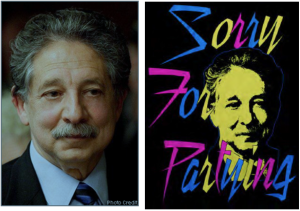How much of a photo do you need to alter to avoid copyright infringement? Hint: Cheshire Cat
Fairly Used 2017-10-06
Bloggers and artists often ask, “how much of a photo do you need to alter to avoid copyright infringement?” Five changes? Fifteen? The Seventh Circuit addressed the issue in the Kienitz v Sconnie Nation case recently. According to the court, Sconnie Nation made t-shirts displaying an image of Madison Wisconsin mayor Paul Soglin, using a photo posted on the City’s website that was authored by photographer Michael Kienitz.
The court looked to the Cariou v Prince decision, but complained that its approach to appropriation art looked only at whether a work is “transformative” and doesn’t fully address a copyright owner’s derivative rights under 17 U.S.C. Sect. 106(2). This court analyzes the market effect, looking to see if the contested use is a complement to the protected work (allowed) rather than a substitute for it (prohibited).
The photographer in this case did not claim that the t-shirt was a disruption to his own plans to license the photo for t-shirts or tank tops. He did not argue that demand for the original work was reduced.
And as for Fair Use factor three, the amount and substantiality of the portion used … the court wrote “Defendants removed so much of the original that, as with the Cheshire Cat, only the smile remains.” The original background is gone, its colors and shading are gone, the expression in the eyes can no longer be read, and the effect of the lighting is “almost extinguished.” “What is left, besides a hint of Soglin’s smile, is the outline of his face, which can’t be copyrighted.”
The post How much of a photo do you need to alter to avoid copyright infringement? Hint: Cheshire Cat appeared first on Stanford Copyright and Fair Use Center.
